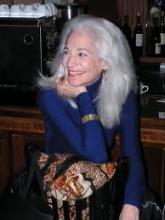Mary Tabor’s absorbing new collection of short stories
Blurring the line between fiction and real life is one of the intrigues of good writing. Much of Saul Bellow’s wild antics in “Humboldt’s Gift” actually happened to him, but how much? Did Philip Roth’s “Portnoy’s Complaint” originate in his personal life?
Intriguing, perhaps, but none of this really matters if the story is credible and the writing holds up.
Any reader with an analytical bent will wonder, however, where the truth is located in a good story. I certainly did, reading Mary L. Tabor’s new collection of twelve short stories, The Woman Who Never Cooked (Outer Banks Publishing Group). She displays rare knowledge of human behavior in this assemblage of stories covering illness, deaths in the family, adultery, intimacy, dishonesty, dreams, love, family ties, and some surprisingly interesting details about food and how to cook it.

These stories display Ms. Tabor’s polished prose page after page. She has a sure touch for subtle humor as well as for rhythm, repetition, metaphor and simile. In one story she alludes to a man’s admiration of his current obsession, as her “thin, wispy shape like one of Monet’s poplars”. Or as he looked into her eyes, he saw “blue with flecks of white and yellow, reminding him of a Key West at sunset, sapphire blue and sun-struck clouds”.
In “The Trouble with Kitchens”, Olivia suspects her husband has been unfaithful. She had been married before, so “she knew what men could do after they’d been married a while, when a new kitchen was about to be. She knew.”
And as two sisters explore a seedy side of Baltimore, one knows how to discourage attention from men who looked perverse or sick. “She did this with a turn of her head, a swift lift of her chin, a look of disdain. It was effective, in the style of a professional hooker …”
Her inner monologues and flashbacks are carefully controlled ensuring that the reader never gets lost. Some of her sentences seem crafted in poetic meter: “ … my father stood in summer heavy sun and watched his shadow shimmer on the tar”.
Ms. Tabor has revealed her thoughts on fact vs. fiction more than most writers are willing or able to do. In her essay “How does Autobiography Work in Fiction?” ( full text here: https://www.factsandarts.com/literary-essays/how-does-autobiography-work-fiction) she identifies for us the factual origins of three stories, “Rugalach” (a tribute to her mother), “Losing” (a tribute to her father), and the title story that ends the book, “The Woman Who Never Cooked”. This left me speculating on where she merged fact and fiction in the nine others.
Ms. Tabor, an award-winning author and experienced teacher of creative writing, manipulates these two opposites with brilliant effect. In fact, she argues that “fiction is more powerful, more truthful… than the so-called true story.” Good fiction, she rightly maintains, gets to the hard truth of a story in a way that memoir can’t do. She acknowledges that she is “hidden inside the fiction”.
And I was stunned by her assertion that “fiction is more powerful, more truthful, if you will, than the so-called true story”. She goes further, explaining that “self-revelation is part of the process of writing”.
These stories vary from four brief pages to a deeper tale of 42 pages. She has knitted independent stories together by renaming the main character “Olivia” so that all of them interconnect and form “an organic whole”. An avid painter, she also created the still life cover illustration.
They are so involving that they take you to a place Ms. Tabor wants you to be – straight into the story. Reading her, I was so lost in space that I needed a few seconds to return to earth as I closed the book. Good writing does this to me.
END
This article is brought to you by the author who owns the copyright to the text.
Should you want to support the author’s creative work you can use the PayPal “Donate” button below.
Your donation is a transaction between you and the author. The proceeds go directly to the author’s PayPal account in full less PayPal’s commission.
Facts & Arts neither receives information about you, nor of your donation, nor does Facts & Arts receive a commission.
Facts & Arts does not pay the author, nor takes paid by the author, for the posting of the author's material on Facts & Arts. Facts & Arts finances its operations by selling advertising space.

